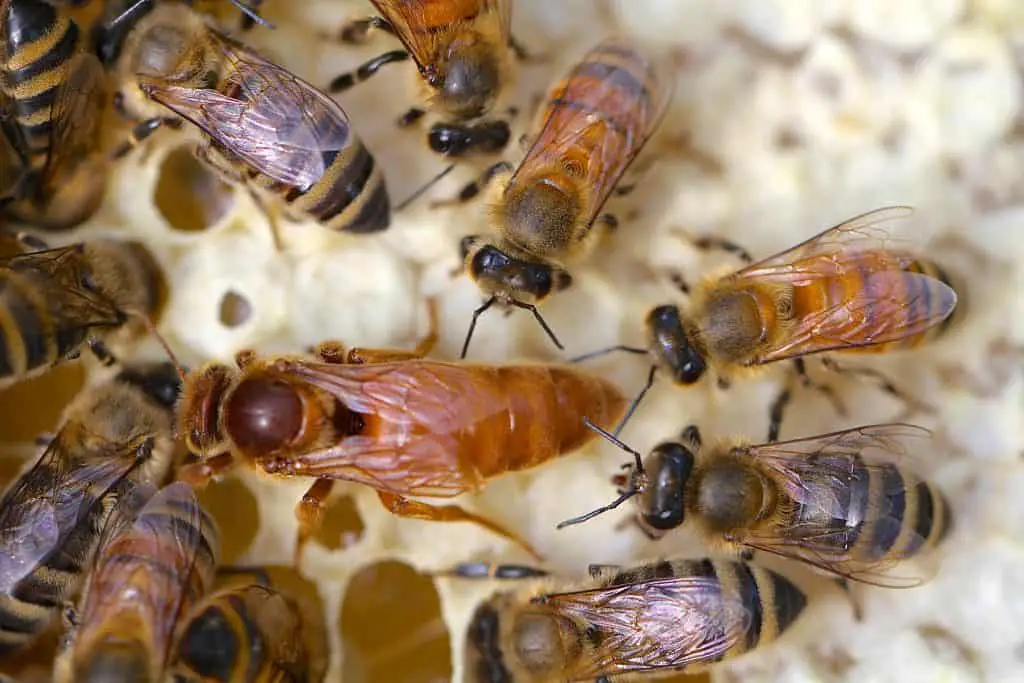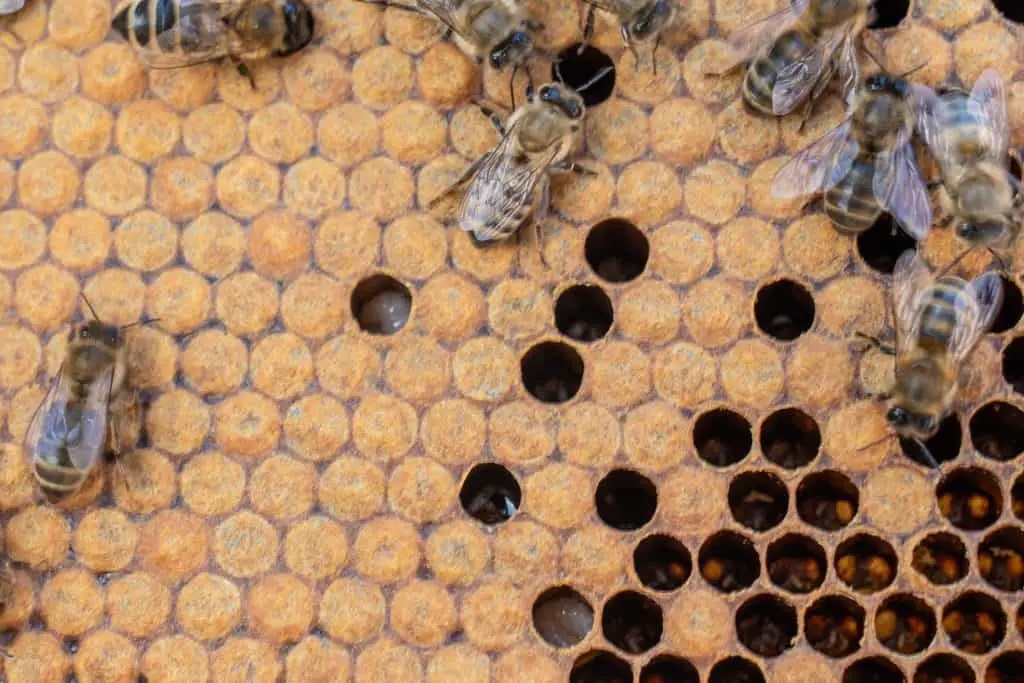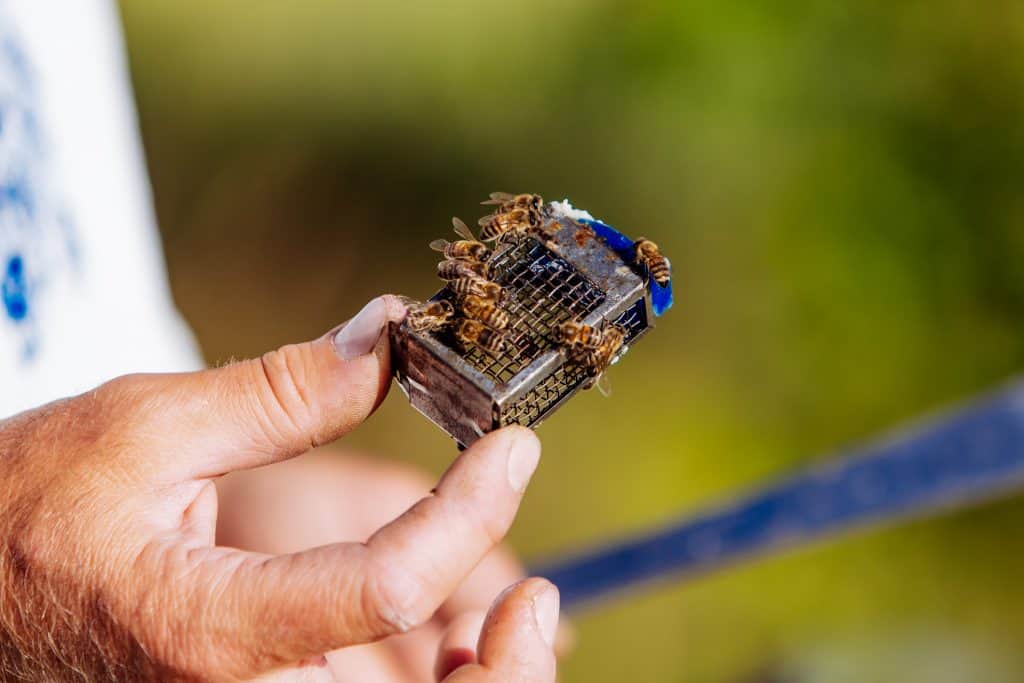Whether you are a beekeeper or are simply interested in bees, you may have wondered what happens when a queen bee dies.
When queen bees die, the most typical result is that the colony acts quickly to replace her by raising eggs in a special way that will make them develop into queens. It is also possible for a beekeeper to introduce a new mature queen into a colony to replace a dead or dying queen.
Because colonies cannot survive long term without a queen, it is essential that the queen is replaced in one way or another when the old queen dies. Because worker and drone bees cannot lay eggs, the queen is essential for the reproductive viability of the colony.
Why is the Queen Bee Important?

The queen bee is essential to the functioning of any honey bee colony because she is the only bee that can lay fertilized eggs that develop into worker bees. Worker bees are essential in the hive because they perform most of the daily tasks that keeps the colony alive.
Worker bees do all of the foraging for food, nursing of young bees, and defense of the hive that keeps the colony alive. Without new worker bees, a colony quickly dies off. Worker bees only live about six to seven weeks, so it is essential that new worker bees are always being produced.
Without a queen bee, these essential worker bees will not be produced, meaning that the colony cannot survive. There will be no food collected, no bees to care for the young larvae, and no bees to defend the hive from predators.
How Long Does a Queen Bee Live?
Queen bees typically live for up to six years. Occasionally, there are queen bees who live longer, and often queen bees are killed by a variety of factors before they die naturally. Some queen bees die natural deaths at just three years old.
What Causes a Queen Bee to Die?
The most common causes of a queen bee’s death are disease, predators, or an error in beekeeping. Additionally, bees sometimes kill their own queen if she is diseased or old.
Parasites such as Varroa mites or Tracheal mites can transmit diseases that can cause a queen bee to die. Additionally, predators such as bears, skunks, and birds can kill queen bees when they enter the nest to feed on honey or the bees themselves.
Finally, if a beekeeper fails to replace queens in a timely manner, they can die of old age without a new queen being in place to replace them. Or, if the beekeeper is performing tests such as alcohol washing to test for mites, and accidentally picks up the queen in the bees that are being tested, she can be killed by the testing along with the other bees.
Do Honey Bees Ever Kill Their Queen?
Bees do sometimes kill their queen as she becomes old or if she has a disease. The worker bees in the colony will intentionally raise new queens to replace her, and then they will kill her by clustering around her very tightly. The worker bees combine their body heat to raise the queen’s body temperature and make her overheat and die.
After the queen bee is killed, the worker bees replace her with new queens. The new queens then make their nuptial flights to mate with drone bees, escorted by worker bees the whole time. The new queens fight for dominance and often kill each other, and finally a single new queen is established and begins to lay new worker bees.
Can Bees Live Without a Queen?
While existing worker and drone bees can survive perfectly well without a queen, the colony cannot produce new bees without a queen present. This means that a colony lacking a queen will eventually die off fairly quickly due to the lack of egg laying that will occur. Therefore, the honey bee species cannot survive long term without a queen.
Additionally, while she is alive, the queen bee releases chemical signals that cause the female worker bees’ ovaries not to function. When the queen bee dies, these chemical signals stop, meaning that worker bees are able to lay their unfertilized eggs. This disrupts the life cycle of the colony because worker bee eggs develop only into drone bees, and the colony eventually begins producing only male bees.
Because male bees are only necessary for reproduction, and do not serve the same purposes that worker bees do, the colony eventually falls into disarray because there are not enough worker bees to perform the daily tasks of the hive. This eventually leads to the colony dying off.
Can Worker Bees Lay Eggs That Will Become Queens?
Worker bees cannot lay eggs that will become queens, because eggs must be fertilized in order to develop into female queen bees. Because worker bees do not mate with male bees, they cannot produce these fertilized eggs and therefore cannot lay new queens by themselves.
However, queen bees are always laying eggs, so even after a queen bee dies there will be eggs that have just been laid that can be raised into queen bees by feeding them a special diet of royal jelly.
What Happens if a Queen Bee Dies Without Laying More Queen Bees?

At the end of the summer, queen bees typically purposefully lay fertilized eggs that will become queens. This is in preparation for swarming, which is a phenomenon which occurs when bee colonies split in half and form a new colony that will move into a new nest. New queens are required for this process because every new colony requires a new queen.
If the original queen bee of the colony dies without laying these queen eggs, the worker bees can still help eggs to develop into queen bees. As long as the eggs are around three days old or less, they can be moved into queen cells and fed on royal jelly and will therefore develop into queen bees.
How Do Bees Replace Their Queen?
To replace their queen, bees select certain young eggs and larvae to become new queens. These eggs must be fertilized so that they will have functioning reproductive systems. Unfertilized eggs laid either by the queen or by worker bees cannot and will not develop into queen bees.
Once they have selected the eggs or larvae that they will raise into new queens, the worker bees place them in special queen cells within the hive. They feed them only on royal jelly, which is a special substance that is fed to bee larvae in order to make them develop into queens.
While all bees in a colony are fed royal jelly, the queen bees receive more royal jelly than the other bees, and are fed solely on royal jelly. Additionally, drone and worker larvae are only fed royal jelly for three days while queen larvae are fed on royal jelly throughout their development. This makes the queen larvae develop functioning ovaries, making them able to produce fertilized eggs.
How Do You Introduce a New Queen Into an Existing Colony?
When a colony is lacking a queen, it is essential for beekeepers to introduce a new queen to keep up with egg laying needs of the colony. There are many ways to do this, including placing the queen in a cage within the hive, using essential oils, or creating a nucleus colony in which to introduce the queen.
It is very important to introduce new queens to a colony carefully, as the worker bees may not like or accept them at first and may be aggressive towards them. Introducing the queen within a cage or using essential oils to calm the worker bees will help the colony accept the queen and not harm her. This is especially true if your colony has older worker bees rather than younger ones.
Using Cages to Introduce a Queen Bee

It is almost always essential to use cages to introduce a new queen bee to a colony in order to protect her from potentially hostile worker bees, who will not accept her at first. The queen needs time to spread her pheromones within the hive so that the worker bees can get used to her smell.
There are many cage types for introducing a queen to a hive, and we’ll cover three popular ones below.
Push-in Cages
Push-in cages are an excellent option when it comes to queen cages because they allow the queen to start laying eggs immediately upon introduction to the hive. They also give the queen a larger surface area where she can release her pheromones and the worker bees can get used to them.
Push-in cages are essentially wire netting that is formed into a half-inch high cage that is then pushed into the existing comb on a frame within the hive. It is best to introduce the queen to the brood comb so that she can start laying eggs there and be warm.
Push-in cages should be set over very specific areas within the comb. The comb should include some emerging bee brood, open honey or nectar cells, and some empty cells that the queen can begin laying in.
The push-in cage can be removed, and the queen can be released after about three to five days, or whenever the worker bees stop hanging onto the cage and can be brushed off of it easily. If the worker bees are still hanging tightly to the cage and have not dug through the wax under the cage to release the queen, it means they have not accepted her and the cage should not be removed yet.
Commercial Cages with Fondant
Commercial cages with a fondant plug are the most common type of cage that queen bees are shipped and sold in. They are tiny, wooden boxes that the queen comes in. They have a small hole in one end that is filled with fondant, a sugary material that the worker bees can eat through.
As the worker bees eat through the fondant plug, they get used to the queen’s pheromones and get to know her. Once the bees have chewed through the fondant plug entirely, the queen can leave her cage and enter the hive.
If the bees do not eat through the fondant within about three to five days, the queen can be released manually from the cage into the hive. As with the push-in cage, if the bees are clinging tightly to the cage that the queen is in, it is not quite time to release her as she has not been accepted yet.
Bermuda Queen Cages
Bermuda cages are made of wire netting, like push-in cages. However, they are installed on a smaller, shallower frame and installed into the hive as a full frame. The advantage of Bermuda queen cages is that they give the worker bees in the colony a large surface area where they can smell the queen’s pheromones and get used to her.
The Bermuda queen cage method also requires a commercial queen cage, which is inserted into the Bermuda cage on one of the corners. The queen at first remains in her commercial cage until the worker bees chew through the fondant plug in the commercial cage. Then, she is released into the full size of the Bermuda cage and is allowed to lay eggs and spread her pheromones over a greater area.
Once the queen is introduced and the worker bees have accepted her, usually after three to five days, she can be released completely from the cage and the small frame that the cage is on can be replaced with a regular frame.
Using Essential Oils to Aid Queen Introduction
A beekeeper can also use essential oils to help the colony adjust to a new queen. This is done by spraying emulsified essential oils and sugar water over the frames and bees within a hive, and then releasing the queen into the hive. This method can be used after the queen has been in a cage for a few days within the hive and still has not been accepted by the worker bees.
Lemongrass and spearmint oils work for this method, and there are also products that are sold that contain these oils and can be used for this purpose. Essentially, the oils distract the worker bees from the introduction of the new queen for long enough that the queen can fill the hive with her pheromones and begin laying eggs.

